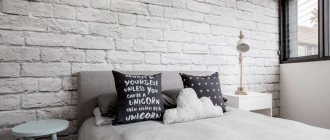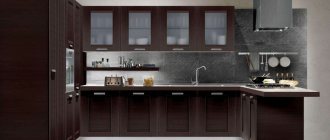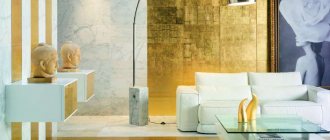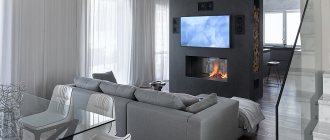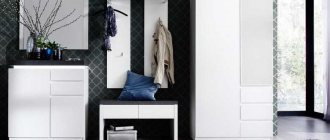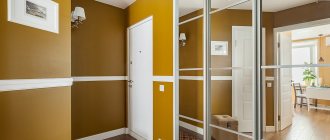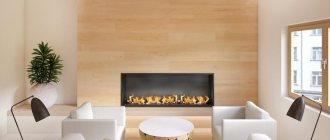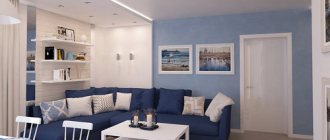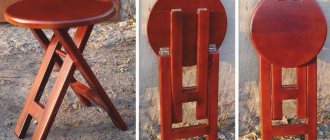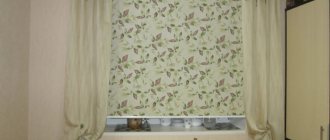The manifestation of their own individuality is characteristic of all people, and they try to do this in everything, including in the design of their homes. Everyone wants their interior design to reflect their character, hobbies, and attitude to life - hence the different choice of style, color and other solutions, the search for their own “zest.”
White brick wall in the interior
It could be a white brick wall in the interior of one of the rooms. The technique is quite common, but not hackneyed. In addition, it can emphasize the originality of any room, from the living room to the bathroom.
White brick in the interior
Brick is one of the very first construction and finishing materials used by man. And it, like wood, stone and metal, will never lose its relevance and will never go out of fashion. On the contrary, it will attract attention against the backdrop of modern materials, evoke a desire to touch and rest your eyes.
Wall decoration with white brick: pros and cons
White brick is used quite often in the interior. It can be combined with the design of almost any room, and therefore will be an excellent solution for implementing many stylistic ideas. A white brick wall has its pros and cons. They allow you to understand whether it will be possible to implement design ideas using this element.
| Pros of white brick | Cons of white brick |
| 1. White elements in interior design visually increase the space. 2. With the help of white brick in the interior you can revive almost any style. 3. White brick masonry is available in different price categories and from different materials. 4. Suitable for bedroom, kitchen, hallway, living room and many other rooms. 5. Dense masonry provides good sound insulation. 6. Visually smoothes the uneven surface of the wall. | 1. A room with such renovation requires regular cleaning. 2. A panel made of gypsum and similar materials is afraid of moisture. 4. Professional finishing from natural materials will not be cheap. |
What to rely on when choosing a finishing material
What you will use to create your brick wall largely depends on the purpose of the room and the characteristics of its microclimate. The hallway, in this regard, is not particularly loyal. Wear-resistant materials that do not react to moisture and can be cleaned should be used here. You don't have to worry about leaning against a wall in wet clothes or regularly rubbing against it when sitting down to put on your shoes on a bench. Taking into account all of the above, we can safely conclude that the ideal solution for decorating the hallway would be natural and clinker bricks, and plastic panels. But foam plastic imitations and wallpaper should be treated with caution. They may not be able to withstand such treatment for long.
Decoratively, tiles with imitation brickwork and a “collapsing edge” effect will look great in the hallway. With the help of such decor, you can create zoning of rooms. This is true when the hallway immediately goes into the kitchen or leads straight into the living room. It is better to decorate a brick wall with original design lamps, alternatively imitating candles.
As for color, it is still better to lean towards a light palette, since the layout of the hallways does not include windows and it is quite dark there.
White brick in interior styles
White bricks can be combined with various interior styles. The main thing is to know what accents need to be made and where to emphasize the uniqueness of the combination for the sake of the interior design.
Scandinavian style
White decorative brick in a Scandinavian style interior should play one of the leading roles. Nordic design notes love cool and light colors, so it is better not to choose small areas. Large white brickwork will be appropriate on the entire surface of the wall of a living room, bedroom or hallway in a Scandinavian style.
Loft
In the loft style, surfaces finished with red brick or other materials with “natural” shades are more common. But the good thing about this style is that it combines many unusual solutions with an emphasis on brevity and a challenge to glamor. An imitation of natural white brick would be appropriate in a nursery or living room. To enhance the brightness of the style, it is worth choosing contrasting decorative elements, black or brown, made of wood and metal.
Provence
In the Provence style, the material is appropriate only in the interior of the kitchen: a small apron with neat masonry will become a bright accent of the room, which should not be overloaded with an abundance of other decorative elements.
Classic
Classic and white brick go well together. The material or its imitation would be appropriate in the living room. The white masonry above the fireplace will be the highlight of the room.
boho
White brick tiles in a boho interior will reduce the brightness level. It can be used to decorate the wall of a living room, bedroom or kitchen. To emphasize the ethnic boho mood, the masonry is decorated with hanging decor - carpets, jewelry, masks with fringe made from natural fabrics and materials.
High tech
Interior design in high-tech style is rich in dark, cool shades: gray, black, dark brown. The combination with a white brick wall will be advantageous if the masonry imitates natural material. It is better to cover the surface with glossy varnish and not use dense textures.
English style
This direction has absorbed several styles at once. Elements of country, loft, the mood of Provence and classics - all this is the English style, most appropriate for country housing. Here, brick is used in large spaces, more often in the kitchen and living room. Paintings, dark furniture and wood will dilute the light walls.
Modern interior
The apartment in a modern style combines many directions. To prevent the decor from looking pretentious and aggressive, use a plaster background made of white brick. Living room, bedroom - modern style masonry will be appropriate everywhere except the bathroom.
Features of the loft style
A characteristic feature of loft design is not only brickwork, but also many other features that make the interior recognizable and aesthetically pleasing. This design trend itself originated in America in the 30s of the last century, when, due to the crisis, many people in cities were forced to rent premises in former factories and factories.
This is where the style got its famous industrialism and brutality.
Articles on the topic (click to view)
- How to choose a floor lamp for your home
- Photo of the interior design of a small living room in an apartment in 2022
- Choosing colors for the room
- Photo of modern interior design with electric fireplace
- Photo of curtain design for the kitchen and living room with two windows
- How to make a mini bar for storing alcohol in the living room
- Built-in wardrobe with TV for the bedroom
In addition to bare brick and concrete walls, loft designs feature an abundance of natural light. Huge windows were installed in the production premises, which let in enough sunlight to illuminate large industrial areas.
As furniture in the loft, only the most necessary interior items are used, without which it is impossible to live normally in the room - beds, sofas, armchairs, tables, chairs, shelves, etc. All of them must also be made in the same industrial style, only in this In this case, the apartment will look attractive and aesthetically pleasing.
The most popular colors in loft interiors: gray, brown, beige, black. Typically, cool shades and a lot of light colors are used, making the room visually look even more spacious and cozy.
In which rooms is brick suitable?
White brick interior is an ideal solution for almost all rooms. It is less common in the toilet and bathroom, more often in the kitchen, living room and hallway.
What goes with white brick in the interior?
In the interior of an apartment or country house, white brickwork is appropriate almost everywhere. What material goes best with:
- wooden cabinets, furniture, dishes;
- metal tables, racks;
- concrete plates;
- mirrors of standard shapes;
- wallpaper or plain putty;
- home flowers in plain pots and cache-pots.
White brick wall in various rooms
A white brick wall adds light and a well-groomed look to the interior. Therefore, it is found in many rooms.
Hallway
White brick in the interior of the hallway is one of the best types of wall decoration. If the space is small, it will visually enlarge it. But then, instead of natural material, it is better to use clinker and wallpaper. In a wide hallway, you can make white masonry from natural brick, diluting it with contrasting furniture or laconic decorative elements - paintings, vases, souvenirs on the shelves.
Living room
White brick in the living room interior should not “argue” with other decorative elements. It is better to put it behind furniture, a TV, large paintings or a fireplace.
Kitchen
When laying brick kitchen backsplashes, you should choose a reliable material: it should be resistant to high temperatures and water, easy to clean and preferably with a glossy varnish coating (makes maintenance easier). Brick-like wallpaper is also appropriate in the kitchen interior: you can dilute the light walls with flat pictures, flowerpots or hanging decor.
Bedroom
There should be little white brick in the bedroom interior. It is enough to decorate the space behind the bed with it so as not to deprive the room of warmth and comfort. Decor made from natural materials is the best solution for contrasting finishing of a brick surface.
Bathroom
A bathroom with white brick is rare. But it is quite appropriate if it is a natural material or clinker. It is better to install the tiles on 1-2 walls, diluting everything with a set of furniture or plumbing fixtures in the same style.
Balcony and loggia
MDF and natural brick for a balcony are not an option. The first one is afraid of cold weather, the second one is too heavy material. But you can use clinker, PVC or cover all the walls with wallpaper.
Imitation clinker brick
Clinker brick is a special brick made from certain types of clay. This brick actually resembles natural brick more than any other material. Clinker itself is quite dense, so it is impossible to create it at home. When making such bricks, a special technology is used: firing is carried out in kilns with a temperature of 1200 degrees.
On a note! When operating, be sure to use a special glue, ideally from the same company as the brick itself. And don’t forget to pay close attention to the shade of all the bricks. Quite often, one set can contain bricks of different colors.
Varieties
Brick walls can be not only natural, but also an imitation of the material. The choice of a specific type depends on the style, size of the room and the characteristics of the tile.
From plaster
It is light in weight and is not afraid of temperature changes. However, it cannot be used in rooms with high humidity.
Made of ceramics
The material is suitable for any room, including the bathroom. Ideally imitates natural brick. It is durable, not afraid of moisture and temperature changes. But you cannot create the effect of “torn” tiles with it.
From porcelain stoneware
It is not afraid of frost and dirt; the tiles are easy to care for. But high-quality porcelain tiles, especially with a white surface, are almost impossible to make at home. The kitchen and hallway look most impressive with this material.
Clinker
Ideally imitates natural brick. Not afraid of cold and sun, suitable for country houses, balconies and loggias. Manufactured only in specialized production.
Imitation brick made of porcelain stoneware
Ceramic granite is the most reliable and high-quality material for creating bricks. It differs from ceramics in that during production granite shavings are added to the solution, and then the material is fired twice in a kiln. This is what gives it such strength and durability.
The advantages of porcelain stoneware bricks include:
- Full resistance to temperatures (withstands frosts down to -50)
- Moisture resistance
- Easy to clean and does not absorb dirt
- Service life from 30 years.
The colors can be any - on store shelves there is a large selection of shades that will suit any interior.
On a note! Porcelain stoneware is perfect not only for wall cladding, but also for floor cladding. Very often it is used simultaneously on two surfaces.
Porcelain stoneware brick looks original and interesting in the bathroom, dining room or kitchen, as well as in the hall.
How to choose
When choosing white brick for your home, you should consider a number of factors:
- Interior style. White brick goes with almost all styles, but there are exceptions.
- Dimensions of the room (especially width). Photo wallpaper for a narrow corridor will be more appropriate than natural brick, the installation of which requires sacrifice in the form of priceless centimeters of space.
- Budget. Natural tiles or porcelain stoneware are more expensive than gypsum, PVC, MDF, but are not always more suitable.
- Temperature. Not all materials withstand frost and sudden climate changes equally.
- Humidity. Gypsum is not the best option for a bathroom, unlike clinker or natural brick.
The masonry can be purchased or made independently. It all depends on the budget and the characteristics of the chosen material.
Imitation brick made of gypsum
As mentioned above, gypsum imitation brick is the most budget-friendly and practical material. Gypsum has a greater variety of textures and colors, so the masonry can be absolutely anything. The next plus is the complete absence of transformation due to temperature changes.
Note: the disadvantage of this material is that it is not at all moisture resistant. In order to avoid various troubles associated with this, a special varnish must be applied to the surface of the material.
Gypsum stone is:
- Matte is a simple and budget option; this texture will not have shine, but it looks calm and discreet.
- Glossy - adds some shine to the interior.
- With a torn texture - this texture does not have a smooth surface.
- Volumetric - has a concave or convex shape
- Relief - thanks to relief overlays, an unusual and original brick shape is created.
Gypsum is not a capricious material in its structure, but it has its own number of features. If you want to carry out a completely budget repair, then we suggest making plaster with your own hands . Yes, it's easy to do.
The process of making gypsum masonry at home
To make gypsum brickwork you will need the following materials:
- Gypsum dough
- Brick molds
- Special lubricant
- Gypsum hardener
- Dye
You can easily purchase all materials at a hardware store. In one of the articles we published a list of DIY stores (Do it yourself). There you will find the most common dough for gypsum products, a lubricant for removing finished products from the mold, and a hardener - your assistant for improving the strength of the brick being made. And, of course, paint, which will give your material a more natural look. It is not recommended to leave the natural color of the plaster, because... it will quickly lose its freshness and become dirty.
Now that everything has been purchased, you can begin making the gypsum bricks itself.
1. Knead the gypsum dough in a bowl of hot water (the water should not be cold or room temperature). To do this, add gypsum powder to the container, stirring constantly. A construction mixer will help you stir the resulting mixture. It will evenly do this for you, especially if you have large volumes of such a mixture.
2. Add the desired pigment to the solution during the mixing process.
On a note! If you want to achieve beautiful stains on gypsum bricks, then pour the paint at the end, stirring it lightly until multi-colored stripes remain.
3. After thoroughly stirring, pour the resulting mixture into specialized molds (note that the molds must be thoroughly greased before you pour the gypsum solution into them).
4. Wait for the form to completely harden. The hardening time depends primarily on the volume of the mold.
5. Once you understand that the shape has solidified, you can remove the object using a specialized rubber mallet.
On a note! If you want to protect the product from damage, then you can coat the brick with varnish or some other protective agent.
Gypsum brick is an economical and easy way to add originality to your interior. This is what determines the popularity of such material over others. Experiment and you will create an interesting and beautiful design!
Methods for creating brickwork in the interior
White walls are a stylish and modern solution, especially for small spaces. When choosing a brick material, consider what laying methods the market offers.
Natural brick
White and red brick are natural materials that are not afraid of moisture. They are appropriate everywhere except narrow rooms and balconies. The disadvantage is that installation is quite difficult - for even installation it requires experience and dexterity.
Facing tiles
Differs in a variety of shapes and colors. You can choose plain white tiles or in combination with gray, black or other masonry. The material is easy to install and maintain. Differs in types: gypsum, clinker, porcelain stoneware, artificial stone.
Wall panels
A ready-made solution for large rooms. It does not require lengthy installation, but its imitation is not always better than that of tiling.
Putty bricks
A budget option. It consists of drawing with a brick on a putty surface. It takes a lot of time and requires patience and skills, since the work is done on a light surface literally “by eye.”
painted brick
The most labor-intensive way to create masonry. Requires skill, patience, dexterity. Due to the lack of volume effect, it does not look so natural. When ordering the services of a master, it is an expensive procedure.
Wallpapers and photo wallpapers
White brick wallpaper in the interior is suitable for small rooms, narrow kitchens or hallways. They decorate large spaces. Easily combined with voluminous paintings and wall decor.
Types of decorative bricks
There are several types of decorative bricks on the modern market. Therefore, if necessary, choosing the ideal option for yourself will be quite simple.
Clinker brick
This type of decorative brick is often called ceramic, since the clay from which it is made is subjected to double hardening, which allows the coating to withstand temperature changes, exposure to various types of pollution, mechanical damage and moisture. “Clinker tiles” are produced on the same principle as bricks, but are smaller in size, namely in thickness. This wall covering is offered in a variety of textures and colors and is perfect for decorating an eco-style interior.
Gypsum brick
The production of decorative bricks from gypsum does not require large investments, so this type of cladding has an attractive price, has a lot of positive qualities, but, unfortunately, is fragile and sensitive to moisture. Gypsum brick is used to decorate walls, individual areas or doorways. Can be painted or used in its original form.
Glass fiber reinforced concrete brick
Decorative brick with such an intricate name is a mixture of cement with quartzite glass threads, which are used as binding fibers. The material has amazing colors, is characterized by high strength and resistance to chips. Compared to natural stone, it is lighter in weight and compact in size.
Flexible brick
A facing material of this type appeared on the building materials market quite recently and is a semblance of ordinary decorative tiles, prone to deformation. Even with slight heating, the shape of such a brick will begin to change, so if you decide to decorate the walls in the hallway with a “flexible” coating, place it as far as possible from lamps or wall sconces. All kinds of mosaic masonry as decoration in this case can be called the most successful option.
How to make white bricks in the interior yourself
A simple way to make imitation brick:
- Take thick foam and thick cardboard.
- Cut out templates from cardboard, and use foam “bricks” on them.
- Cut the resulting brick widthwise into two halves.
- Remove the chamfer around the perimeter of each brick.
- Take liquid nails and glue the foam to a previously prepared surface: markings on chipboard, plywood, in a checkerboard pattern.
- Apply 2 layers of acrylic paint and varnish.
